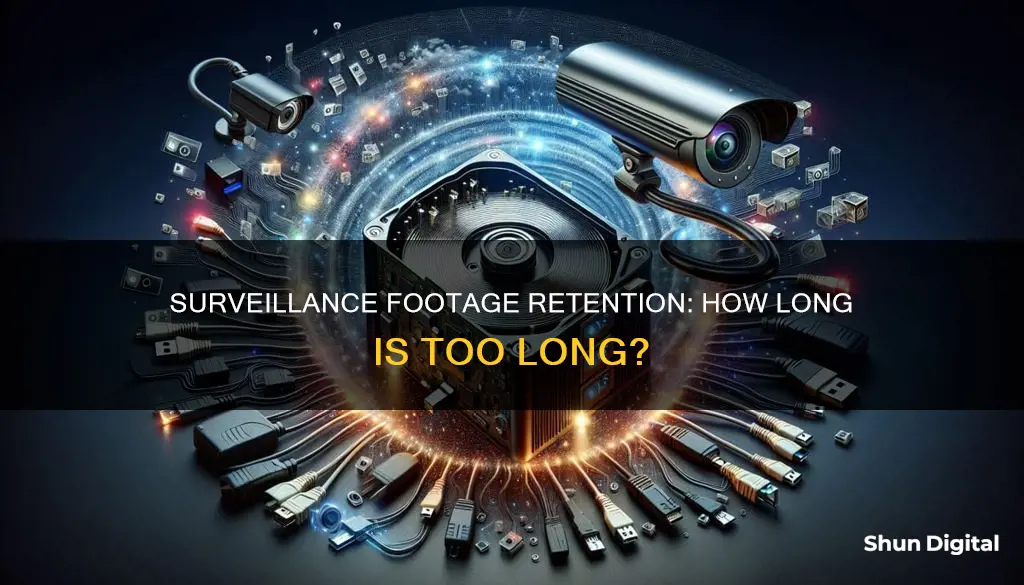
The retention period for security camera footage varies depending on the industry, storage capacity, and regulatory requirements. Typically, most security camera footage is retained for 7 to 90 days, with some high-capacity systems storing footage for months. Cloud-based systems offer subscription plans with varying retention periods. Factors such as motion-activated recording, continuous recording, and legal mandates also influence the duration for which footage is kept. Industries like banking and casinos have longer retention periods, often ranging from six months to a year, to comply with regulations.
| Characteristics | Values |
|---|---|
| Typical Retention Period | 7 to 90 days |
| DVR/NVR Systems Retention Period | 7 to 30 days |
| Cloud-Based Systems Retention Period | 7 days to several months |
| Motion-Activated Recording Retention Period | Depends on the frequency of motion events |
| Continuous Recording Retention Period | Shorter than Motion-Activated Recording |
| Manual Deletion or Overwriting | Yes |
| Legal and Regulatory Requirements | Varies based on jurisdiction and establishment type |
| Casino Retention Period | 6 months to 1 year |
| Bank Retention Period | 6 months or more |
What You'll Learn

How long do security cameras keep footage for?
The duration for which security cameras retain footage varies and is a critical aspect of surveillance. The loss of crucial footage could create a void in addressing critical incidents, understanding security patterns, and ensuring the lasting impact of surveillance systems.
Typically, security camera footage is retained for 7 to 90 days, with 30 to 90 days being the most common duration across various sectors, including hotels, retail stores, and supermarkets. However, the specific duration depends on the type of system, storage capacity, recording settings, and user preferences.
DVR/NVR systems, for instance, may retain footage for a few days to several weeks, typically 7 to 30 days. In contrast, some high-capacity systems can store footage for months. Cloud-based systems offer subscription plans, with basic plans offering limited storage for a few days to a week, while premium plans extend this duration to several weeks or months.
Motion-activated recording systems conserve storage by recording only when motion is detected, and their retention duration depends on motion frequency. Continuous recording systems, on the other hand, have shorter retention periods due to their reliance on larger storage capacities.
Legal and regulatory requirements also play a role in retention periods. For instance, banks usually store footage for up to six months to comply with regulatory standards, while casinos may retain footage for six months to a year due to state regulations.
The quality of the footage also influences storage duration. Higher-definition or 4K video files are larger and will fill up storage space faster. Additionally, the number of cameras, camera resolution, compression settings, and recording mode (continuous or motion-activated) impact the required storage capacity.
In summary, the duration for which security cameras keep footage varies depending on the system, storage capacity, industry regulations, and user preferences. Businesses should plan for adequate storage growth to accommodate their surveillance needs.
Airline-Approved: Small Cameras with Lithium Batteries
You may want to see also

What are the different storage options?
There are several storage options for surveillance camera footage, each with its own advantages and disadvantages. Here are the most common ones:
SD Cards
SD cards are a popular option for those who want to store motion-triggered footage or avoid cloud service subscriptions. They are relatively safe and inaccessible to others, making them a good choice for homeowners who want to monitor their front door, backyard, or any area that doesn't require constant recording. SD cards are also useful in locations with limited internet access. However, they have limited storage capacity and may not be suitable for constant 24/7 recording.
NVRs/DVRs
Network Video Recorders (NVRs) and Digital Video Recorders (DVRs) are standalone devices that store video footage externally. They are widely used for home security systems, small businesses, and workshops. NVRs/DVRs can record video constantly and store weeks of footage, making them ideal for those who need long-term storage. They can also manage multiple cameras simultaneously. However, they are vulnerable to theft and may require regular backups to prevent data loss.
FTP
File Transfer Protocol (FTP) servers are suitable for those who prefer not to use cloud storage but still want a remote storage option. FTP servers can handle both motion-based footage and constant video recordings. However, they may require a subscription or additional costs for storage space.
Cloud Storage
Cloud storage is gaining popularity due to its convenience and enhanced security. It acts as a backup to local storage and can be accessed from anywhere through mobile devices. Cloud storage also allows for additional features, such as person and vehicle detection. However, it requires a stable internet connection and usually comes with a monthly fee.
Personal Computers
Personal computers can be configured to store surveillance footage, especially for motion-triggered videos. However, storing massive amounts of data on a personal computer can slow it down and quickly consume storage space.
NAS
Network-attached storage (NAS) is a flexible option that allows recording from security cameras of different brands. It is typically recommended for up to three channels, as using more may require a different storage solution. NAS provides the benefit of recording from various camera brands in one place.
The choice of storage option depends on specific needs, such as the duration of storage, number of cameras, resolution, frame rate, and budget. Each option has its advantages and limitations, so it's essential to consider these factors when deciding on the most suitable storage solution for surveillance camera footage.
Smart Strategies for Carrying Extra Camera Batteries
You may want to see also

How does footage storage duration vary across industries?
The duration for which security cameras retain footage varies across industries and is influenced by factors such as legal and regulatory requirements, storage capacity, and organisational policies.
Retail, Hospitality, and Construction Industries
Hotels, car dealerships, retail stores, supermarkets, and construction companies typically retain security camera footage for 30 to 90 days. This duration is influenced by the storage capacity of their systems and the specific needs of each business.
Financial Institutions
Financial institutions, such as banks, often have regulatory standards that require them to store security footage for extended periods. Compliance with these regulations can lead to retention periods of six months or more, with some sources mentioning retention periods of up to seven years.
Casinos
Casinos are subject to varying state regulations that dictate the retention of security footage. These regulations can require casinos to retain footage for periods ranging from six months to a year.
Healthcare
In the healthcare industry, specific facilities may have unique retention requirements. For example, medical marijuana dispensaries in Ohio are mandated to maintain 24/7 security footage for a minimum of six months.
Other Factors Influencing Retention Duration
In addition to industry-specific regulations and standards, the retention duration can also be influenced by the specific storage systems employed. Cloud-based systems, for instance, may offer subscription plans with varying retention periods, while systems that utilise motion-activated recording can retain footage for longer periods by conserving storage space.
BHS Camera Tickets: When Are They Issued?
You may want to see also

What factors affect the storage capacity of security cameras?
The storage capacity of security cameras is influenced by several factors, each playing a pivotal role in determining the required storage capacity. These factors include:
Camera Resolution
The resolution of your CCTV cameras directly impacts storage requirements. Higher resolutions, such as 4K, produce more detailed footage but demand larger storage capacities. Conversely, lower-resolution videos take up less memory but at the expense of clarity. Common resolutions for modern security cameras include 1080p, 1440p (2K), and 4K.
Frame Rate
The frame rate, measured in frames per second (fps), also affects storage space. Higher frame rates yield smoother videos but necessitate more storage. While not all cameras allow fps adjustments, a higher frame rate is beneficial in low-light conditions. Common frame rates include 15, 30, and 60 fps.
Video Compression
Video compression techniques, such as H.264, H.265, MJPEG, and MPEG4, are crucial for storage efficiency. Compression reduces file sizes, minimizing the required storage space. H.265 compression, for example, can decrease file sizes by up to 50% compared to H.264.
Bitrate
Bitrate influences both video quality and storage needs. Higher bitrates enhance video quality but also increase storage demands. The interplay between resolution and compression formats further impacts bitrate requirements. Adjusting the bitrate according to storage capacity and video quality expectations can help manage storage.
Number of Cameras
The number of cameras in your setup directly impacts storage needs. Employing multiple cameras simultaneously escalates storage requirements.
Retention Period
The duration for which you intend to retain CCTV recordings directly correlates with storage capacity. Longer retention periods require larger storage capacities. Continuous recording consumes more space, whereas motion-activated recording conserves storage by capturing footage only when movement is detected.
Storage Type
The type of storage used also affects capacity. Local storage solutions like microSD cards, DVRs, or NAS devices have limited storage capacities. Cloud storage solutions, on the other hand, often offer subscription plans with varying storage capacities and retention periods.
Video Encoding Settings
Settings related to video encoding, such as bitrate and compression levels, can impact file sizes. Higher bit rates generally yield better video quality but also result in larger file sizes.
Recording Mode
The chosen recording mode influences storage needs. Continuous recording consumes more storage compared to motion-activated recording. Scheduled recording, where cameras are set to record only at specific times, can significantly extend storage life.
Compression and Storage Efficiency
Some CCTV systems feature smart compression algorithms that enhance storage efficiency, reducing the amount of storage needed for a given amount of footage.
Video Analytics
If your CCTV system incorporates advanced features like object detection or facial recognition, it may generate additional data that requires storage.
Understanding Camera Modes: What Does S Mode Do?
You may want to see also

How can footage be kept for longer?
To keep security camera footage for longer, there are several strategies that can be employed:
Scheduled Recording
Instead of continuous recording, set cameras to record only at specific times, eliminating unnecessary footage and significantly reducing storage space usage. For example, scheduling cameras to record only at night can more than double your video storage time.
Motion Detection Cameras
Use motion detection cameras that record only when there is movement, enhancing accuracy and security. Modern cameras with line-crossing functions allow you to monitor specific areas for movement and unauthorised entry. Adjust motion detection settings to capture relevant events without filling up storage too quickly, especially in areas with high motion.
Export Footage
Export camera footage to a computer or a separate hard drive, such as a thumb drive, to preserve it indefinitely without using up the main storage space. Selectively export important events or footage for future reference.
Video Compression
Implement video compression techniques, such as H.265, to reduce the size of your footage and create more room in your storage system. Compression uses a codec to eliminate unnecessary files and shrink existing ones without compromising video quality. This frees up space, allowing you to store more footage.
Adjust Recording Settings
If high-quality footage is not essential for your purposes, consider reducing the recording resolution or frame rate. Lowering these settings can save a significant amount of storage space.
Disabling Camera Mode in VAM: A Step-by-Step Guide
You may want to see also
Frequently asked questions
Typically, most security camera footage is retained for a period of 7 to 90 days. However, there is no standard answer to this question as it depends on various factors such as the type of system, storage capacity, industry regulations, and user preferences.
The duration for which security cameras retain footage depends on several factors, including the camera system's storage capacity, the video resolution, frame rate, compression settings, and recording mode (continuous or motion-activated). The type of industry and compliance with legal and regulatory mandates also play a role in determining retention periods.
Yes, there are several ways to extend the storage duration of your surveillance camera footage:
- Use motion-activated recording or scheduled recording instead of continuous recording to conserve storage.
- Increase storage capacity by using higher-capacity devices or cloud-based storage solutions.
- Adjust camera settings such as resolution, frame rate, and compression to optimise storage efficiency.







